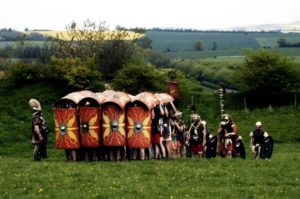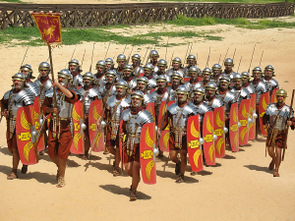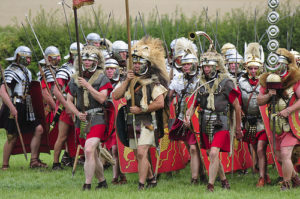Ancient Roman Tactics: The battle tactics of ancient Rome were gradually refined with time as the types of terrain and enemies changes. The great ability of ancient Rome was that of learning from mistakes and picking up the best of what the enemy had to teach.
Ancient Roman Tactics
Ancient Romans had a wide array of defense and offense weapons that helped in war tactics. Most of their weapons were superior to their contemporaries. However, the main and primary ancient Roman weapon used by the Roman legionaries was a spear.

There is an advantage of height over the enemy and if you are pitting infantry against cavalry, the rougher the ground the better. The sun should be behind you to dazzle the enemy. If there is strong wind it should blow away from you, giving an advantage to your missiles and blinding the enemy with dust.
Roman phalanx formation
With only about three feet between the rows of soldiers, the Romans would move towards the enemy. The phalanx was a very difficult barrier to break through. If a man in the front was killed, he was replaced by the man behind.
Roman Shield formations
The shields would not only be used to protect the soldiers but to push the enemy soldiers to the ground or to make them break ranks.

The Roman creativity created the formation that outmatched the “Phalanx Formation”. The testudo or turtle formation. The men in the “Testudo Formation” literary form as a turtle. They were protected in front, rear, flank, and overhead.
Roman Tortoise Formation
The tortoise was an essentially defensive formation by which the legionaries would hold their shields overhead, except for the front rows, thereby creating a kind of shell-like Armour shielding them against missiles from the front or above.

The Levites were young and inexperienced soldiers. They were at the front and their main task was to make the early attacks on the enemy. When they were recalled, the Levites passed through the open ranks and went to the back. The front rank was now made up of the Hastati. When they were about 35 meters from the enemy they threw their javelins (pill). Drawing their swords, they now charged the enemy.
Roman Tactics facts
Behind them, the rest of the Roman Army threw their javelins over the heads of the advancing Hastati. The Hastatis and the Principes each when attacking through a javelin which breaks when it lands to prevent it from being thrown back.
Another of which that showed Roman Genius was the creation of an Auxilian Army. Each man that serves for a time of 15 yrs becomes a Roman Citizen. But Rome’s greatest achievement is the Pax Romana or 300 years of peace.

The orb was a defensive position in the shape of a circle taken by a unit in desperate straits. It allows for a reasonably effective defense even if parts of an army have been divided in battle and would have required a very high-level discipline by the individual soldiers.
All these tactics had the same purpose that of breaking the enemy battle line. If a flank can be turned, then the strong center has to fight on two fronts or is forced to fight in a restricted space.
Roman Army Training
Once an advantage like this has been gained it is very difficult to correct the situation. Even in the highly trained Roman Army, it would have been difficult to change tactics during the course of the battle.

And the only units which can be successfully deployed are those in the reserves or that part of the line not yet engaged. Thus the most important decision a general had to make concerned the disposition of the troops.




